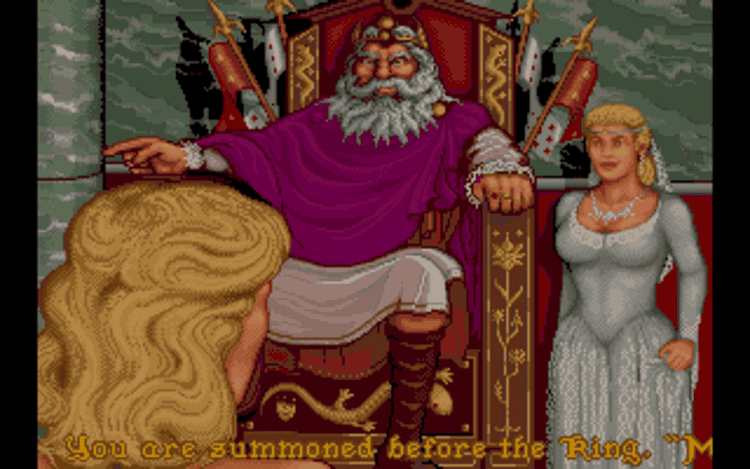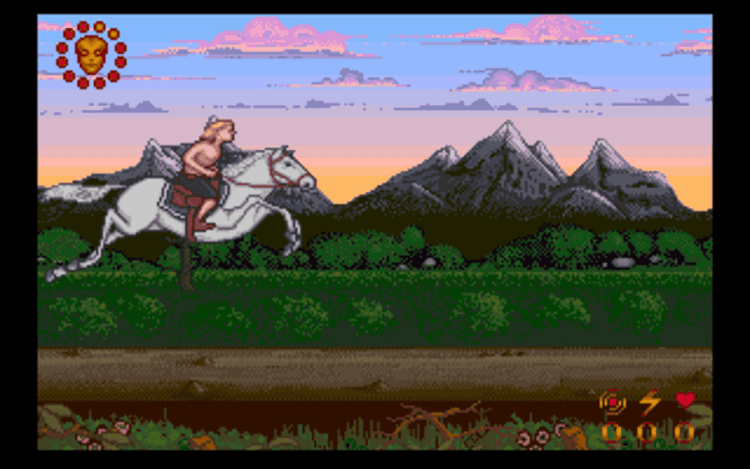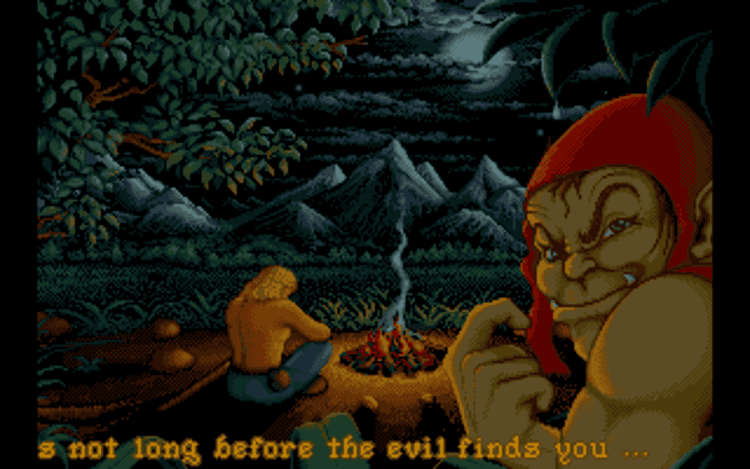
Wrath of the Demon is a fantasy action game published by ReadySof that invites you to guide a lone knight through cursed forests, perilous cliffs, and labyrinthine castles. Its fluid animation and multi-scrolled landscapes recall the cinematic grace of Prince of Persia while echoing the atmospheric menace of Shadow of the Beast. From horseback charges to platform puzzles, every screen feels handcrafted for challenge and spectacle. Whether you play for the sweeping orchestral score or the pixel-rich vistas, this adventure remains a showpiece of DOS artistry that still thrills newcomers discovering the game online today.
Released at the height of the golden age of personal-computer action games, Wrath of the Demon arrived as a showcase for what imaginative developers could achieve on limited hardware. ReadySoft partnered with the Canadian studio Abstrax to craft a side-scrolling epic that blended arcade immediacy with storybook grandeur. From its opening title card—an ominous mountain fortress wreathed in lightning—to its last triumphant cut-scene, the game projects a film-like sensibility. Large sprites sweep across layered backgrounds painted in rich jewel tones, while a stirring score accentuates every clash of steel and crackle of sorcery. Rather than rely on digitized footage or licensed properties, the creators forged an original realm where knights ride sleek stallions, gargoyles screech overhead, and lava rivers glow beneath crumbling bridges. Each location feels alive with craft and personality, reminding modern players that technical limits often spur the most inventive artistry.
Within this animated tapestry the narrative unfolds in minimalist strokes: a demonic overlord has plunged the kingdom into terror, and only a lone champion driven by prophecy can pierce the stronghold and shatter the evil at its heart. Though the plot is intentionally archetypal, its simplicity serves the game’s brisk pace, letting brisk action and atmosphere carry emotional weight. Even decades later, the introduction’s scrolling parallax forests and billowing banners evoke an immediate sense of mythic urgency.
Behind the lush veneer hides a deceptively varied design. Wrath of the Demon is not content with a single mechanic; instead, it weaves multiple play styles into a unified quest. Early stages put players atop a galloping horse, dodging obstacles and slashing mounted brigands in real time. Later sections shift to on-foot platforming where precise jumps and sword thrusts test reflexes against cyclopean ogres and dart-flinging imps. Puzzle interludes break the rhythm, asking adventurers to unlock rune-etched gates or time lever pulls amid rising floodwaters. This variety keeps the experience fresh, ensuring that each new screen offers a surprise rather than routine.
Combat balances accessibility with depth. The protagonist’s blade arcs with a satisfying sweep, yet timing remains crucial; foes telegraph attacks through subtle animations that reward careful observation. Magic orbs collected from vanquished enemies unleash screen-clearing blasts, while hidden potions restore health for those who explore every ledge and alcove. The difficulty curve is forgiving enough for newcomers, yet veterans still relish perfecting flawless runs to chase higher scores and faster completion times. Like its contemporaries Prince of Persia and Blackthorne, the game marries responsive controls to deliberate level layouts, proving that fair challenge never grows outdated.
With modern emulation technology, it has never been easier to revisit—or discover for the first time—this classic game. You can play Wrath of the Demon online free of charge, launching instantly in a browser without installing specialized software. Touch-friendly overlays and adaptable resolutions mean that the same adventure scales gracefully to mobile devices, letting you battle fiends on a tablet during a commute or explore haunted catacombs on a phone curled up at night. No matter the screen, the original visual flair and orchestral soundtrack remain intact, preserving every dramatic flourish.
Because the underlying DOS code is compact and fully self-contained, there are no artificial restrictions or paywalls gating progression. Your quest begins the moment the title scroll fades, and the entire campaign is ready to conquer in one seamless session. Whether you return to recapture childhood memories or approach as a curious historian of interactive fiction, online play ensures that the demon’s realm stays perpetually open to brave souls across generations.
Why does Wrath of the Demon continue to enchant? Part of the allure lies in its commitment to spectacle. Few 2D games of its era dared to combine mode-shifting stages, cinematic interludes, and orchestral compositions in one cohesive package. Another factor is the balance of elegance and intensity: each enemy encounter builds tension without spilling into frustration, and every visual set-piece rewards determination with awe. Speedrunners study its frame-count animations, artists admire its gothic palette, and casual players appreciate a straightforward tale of courage triumphing over darkness.
Crucially, the game remains blissfully isolated from modern trends that can date an experience. There are no procedurally generated shortcuts, no microtransactions, and no server dependencies—just pure side-scrolling craft. That self-contained purity makes it ideal for educational retrospectives on design evolution, classroom demonstrations of pixel artistry, or simple evenings spent chasing heroism after a long day. Each return trip offers the same dependable thrills, proof that well-realized imagination stands outside the march of hardware cycles.
Wrath of the Demon endures because its creators poured ambition into every frame. Controlling the hero feels intuitive: arrow keys guide movement, a primary action key commands sword strikes, and a secondary key triggers magical attacks—controls that remain comfortable on keyboards and virtual touch layouts alike. The journey from verdant lowlands to the demon’s obsidian throne still feels grand, stirring, and wonderfully complete.
All program codes referenced here are publicly available, and Wrath of the Demon remains the property of its original authors.
Share game
Share game




Share game